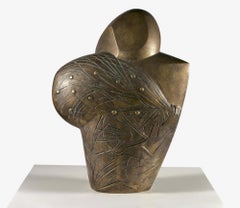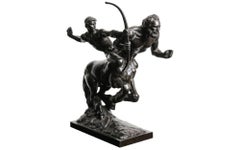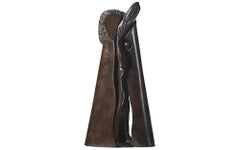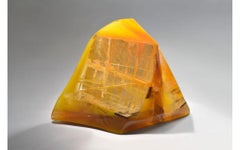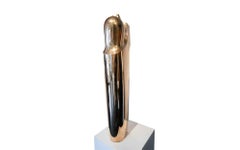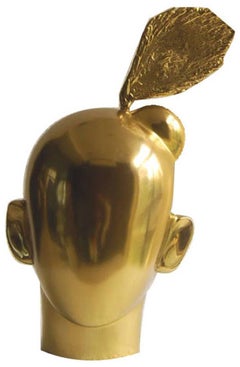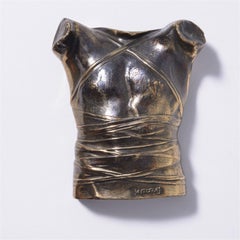BOCCARA GALLERY OFFICIAL Sculptures
to
7
5
2
1
1
1
Overall Width
to
Overall Height
to
5
5
1
2
1
1
6
3
3
2
1
1
1
1
1
1
1
1
1
1
1
1
1
1
1
6
6
2
2
2
2
2
1
1
1
10
La Boisselune
By Émile Gilioli
Located in New York, NY
Émile Gilioli
La Boisselune
1954-59
Bronze
23.6 x 15.4 x 7.9 in, 60 x 39 x 20 cm
Signed, dated and numbered on the back:
“Gilioli, 59, 1/6"
Cast from La Plaine
Edition 1/6
P...
Category
1950s Abstract Abstract Sculptures
Materials
Bronze
Archer and Centaur
By Pierre Traverse
Located in New York, NY
Pierre Traverse
Archer and Centaur
c. 1969
Bronze
17 x 16 x 7 in, 45 x 41 x 17 cm
It is signed by the artist and is an "Epreuve d'artiste" (EA) 3/4
Edition 3/4
Category
1960s Modern Figurative Sculptures
Materials
Bronze
Double Torso
By René Coutelle
Located in New York, NY
René Coutelle
Double Torso
2000
Balkan Onyx
18 x 11 x 7 in, 47 x 28 x 17 cm
Unique Piece
Private Collection of Didier Marien
René Coutelle re...
Category
21st Century and Contemporary Modern Sculptures
Materials
Stone
Young Girl
By Jean-Robert Ipoustéguy
Located in New York, NY
Jean-Robert Ipoustéguy
Young Girl
1989
Bronze
24 x 7 x 11 in, 60 x 28 x 18 cm
Edition 4/8
Private Collection of Didier Marien
Jean-Robert Ipoustég...
Category
1980s Modern Sculptures
Materials
Bronze
Pyramide du Soleil
By Monique Rozanes
Located in New York, NY
Monique Rozanès
"Pyramide du Soleil"
2005
Methyl methacrylate sculpture
13 x 22 x 9 in, 33 x 56 x 23 cm
Inscribed “Monique”
Unique Piece
Private Collection of Didier Marien
...
Category
Early 2000s Modern Sculptures
Materials
Other Medium
Architectural Apparition
By Émile Gilioli
Located in New York, NY
Émile Gilioli
Architectural Apparition
1964
Bronze
40 x 6 x 6 in, 101 x 16 x 16cm
Inscribed “Gilioli” & numbered “2/6”
Edition 2/6
Gilioli’s ...
Category
1960s Modern Sculptures
Materials
Bronze
Personnage en Mouvement
By Jean-Robert Ipoustéguy
Located in New York, NY
Jean-Robert Ipoustéguy
Personnage en mouvement
1976
Bronze
25 x 12 x 12 in, 63 x 30 x 30 cm
Dated and signed "Ipoustéguy"
Edition 5/8
Private Collection of Didier Marien
...
Category
1970s Modern Abstract Sculptures
Materials
Bronze
La Petite Semeuse [The Little Sower]
Located in New York, NY
Pollès
The Little Sower La Petite Semeuse
2010
Bronze
14 x 8 x 8 in, 36 x 21 x 19 cm\
Edition 1/4
In continuity to the tradition of Greek sculpture, Pollès's works lie between Brancusi’s purity, Henry Moore’s figurative abstraction and Modigliani’s flowing siluets and forms. Considered as the inventor of the “Organic Cubism”, Pollès is immediately identifiable through this distant reminiscence of Picasso’s Cubism, mixed with great sensitivity and voluptuousness that characterize his subjects. His personal vision of beings in motion, his sculptures with extraordinary patinas, break the pure aesthetic and create a new, very intimate, mythology.
Pollès has been in collaboration with the Boccara gallery...
Category
21st Century and Contemporary Figurative Sculptures
Materials
Bronze
Vénus
Located in New York, NY
Kyoko SASAÏ
Vénus
2021
Acrylic painting on canvas with interior trim
15 x 5 x 1 in, 38 x 14 x 2.5 cm
Unique Piece
Category
2010s Abstract Figurative Sculptures
Materials
Acrylic
Venus
Located in New York, NY
Kyoko SASAÏ
Venus
2021
Acrylic painting on canvas with
interior trim
44 x 25 x 5 in, 114 x 64 x 14cm
Unique Piece
Category
2010s Abstract Figurative Sculptures
Materials
Acrylic
Related Items
Krishna, Hindu God, Bronze Sculpture, Indian Artist K.S. Radhakrishnan"In Stock"
By K.S. Radhakrishnan
Located in Kolkata, West Bengal
K.S. Radhakrishnan - Krishna - HT : 13 x W : 10 x CIR : 20 inches
Bronze Sculpture.
Krishna : Figurative sculpture of Hindu God by great Modern Indian Artist K.S. Radhakrishnan who has successfully brought about a defenitive resurgence in Indian sculpture.
Style :
K.S Radhakrishnan is one of the most notable among the new generation of sculptors. Like many of his contempories he is a figurative sculptor, but his preference for modelling and bronze casting sets him apart from the rest of them. Recharging age old sculptural processes with a new sensibility, thus is the singular challenge he brings to modern Indian sculpture. And this makes him a modernist - who approaches his work with discernible ambition and considerable aplomb while steering clear of brinkmanship.
Radhakrishnan's works often drawn from the emotions and myths of the Hindu gods, such as Shiva, Kali and Radha. His sculptures are often larger than life-sized; placed in the outdoors, they evoke a superhuman atmosphere. Over the years, Radhakrishnan has experienced with alternate sculpting mediums, working in molten bronze, beeswax and Plaster of Paris.The physical process of working with the materials becomes a performance in itself. The sculpture is the product of a tactile engagement with his medium.
With celebration of sensuality as one of its running themes, his works is at once both intimate and universal in its appeal. A personal commemorative sculpture, with a scale and presence that holds well in natural settings, his work has found permanent home in a number of public collections all over the world.
About the Artist and his work :
Born : Born 1956, Kerala.
Education :
1979 : B.F.A. in Sculpture, Viswa Bharati University, Santiniketan, West Bengal
1981 : M.F.A. in Sculpture, Viswa Bharati University, Santiniketan, West Bengal.
Solo exhibitions :
2006 : ’Freehold’ at Museum Gallery, Mumbai
‘Freehold’ at Artalive Gallery, New Delhi
2005 : ’The Ramp’ at Tao Art Gallery, Mumbai
‘Unbearable Lightness of being’ at India International Centre, New Delhi
2004 : ’The Ramp’ at Sridharani Art Gallery, New Delhi
‘The Ramp’ at Bayer ABS Limited Gallery, Vadodara
2000 : ’Musui Maiya’ sponsored by Vadehra Art Gallery, New Delhi
1998 : ’Song of the Road’ – sponsored by International Travel House, ITC, New Delhi
‘Portal’ – Apeejay Lawns, Calcutta, sponsored by Apeejay Surendra, Group, Calcutta
1993 : Centre des Bonds de Marne, LePerreux-Bry sur-Marne, Paris, France.
1987 : Jehangir Art Gallery, Mumbai.
Participated Exhibitions :
2007 : ’Darpan’ an exhibition sponsored by Nvya Gallery, New Delhi
Travel to Moscow and St. Petersburg, Russia – sponsored by Nvya Gallery.
2006 : Travel to U.S.A, sponsored by Arts India, New York
Travel to Russia, sponsored by Art Resource Trust, Mumbai
Travel to Morocco, sponsored by Popular Prakashan, Mumbai.
2005 : Travel to Istanbul, Turkey to attend artists workshop
Travel to China (Silk Route) sponsored by Uttarayan, Baroda
Travel to South Africa organised by Gallery Navya, New Delhi.
2003 : Travel to Cairo and other cities in Egypt to attend an artists workshop
Travel to France and Italy sponsored by TMI Foundation France
Exhibition titled ‘Can’ curated by Johny M.L
Exhibition ‘Only connect’ at India Habitat Centre, New Delhi
Exhibition ‘Nayika’ by Ganesha Art...
Category
Early 2000s Modern Figurative Sculptures
Materials
Bronze
Petite Cuirasse Bronze Torso Sculpture
By Igor Mitoraj
Located in Lake Worth Beach, FL
Petite Cuirasse Bronze Torso Sculpture
Igot Mitoraj (Polish, 1944-2014)
signed in the mold, from an unnumbered edition of 1500 bronze with gilt patina on lucite base.
Dimensions of...
Category
1970s Modern Figurative Sculptures
Materials
Bronze
Botero Style Bronze Horse Sculpture
Located in Lake Worth Beach, FL
Botero Style Bronze Horse Sculpture
Large and decorative bronze horse with removable saddle Botero style inspired, quality patinated bronze with some red and black trace of paint.
Category
2010s Modern Figurative Sculptures
Materials
Bronze
Gold Gilt Bronze Sculpture Pendant Israeli Tumarkin Abstract Modernist Jewelry
Located in Surfside, FL
Measures about 4.25 X 2.25 inches. Box frame is 17 X 13 inches. Signed by artist verso. From the literature that I have seen I believe the edition size was limited to 10, I do not kn...
Category
1960s Modern Abstract Sculptures
Materials
Gold, Bronze
Arch, Sensual White Carrara Statuary Marble Stone Vertical Figurative Sculpture
By Lutfi Romhein
Located in Clermont-Ferrand, Auvergne-Rhône-Alpes
This Carrare statuary marble stone sculpture in a very pure white with slightly colored veins is by Lutfi Romhein.
A graduate from the Academy of Fine A...
Category
2010s Modern Figurative Sculptures
Materials
Marble
H 27.56 in W 5.52 in D 4.73 in
Bronze Abstract Space Age Book Sculpture LA California Modernist Charna Rickey
By Charna Rickey
Located in Surfside, FL
Charna Rickey 1923 - 2000 Mexican-American Jewish Woman artist.
Signed Bronze House of Books, Architecture Bronze sculpture, signed Charna Rickey and on the front "House of the book." It depicts an open Torah. Original patina.
Approx. dimensions: 7 in. H x 9 in. W x 8.5 in. D. Weight: 13.1 lbs.
Modernist Judaica Sculpture
Born Charna Barsky (Charna Ysabel or Isabel Rickey Barsky) in Chihuahua, Mexico, the future artist lived in Hermosillo and immigrated to Los Angeles when she was 11. She was educated at UCLA and Cal State L.A., she married furniture retailer David Rickey and explored art while raising their three daughters. Moving through phases in terra cotta, bronze, marble and aluminum, she found success later in life. Rickey became one of the original art teachers at Everywoman's Village, a pioneering learning center for women established by three housewives in Van Nuys in 1963. She also taught sculpture at the University of Judaism from 1965 to 1981.
As Rickey became more successful, her sculptures were exhibited in such venues as Artspace Gallery in Woodland Hills and the Courtyard of Century Plaza Towers as part of a 1989 Sculpture Walk produced by the Los Angeles Arts Council. Her sculptures have also found their way into the private collections of such celebrities as Sharon Stone.
Another of Rickey's international creations originally stood at Santa Monica College. In 1985, her 12-foot-high musical sculpture shaped like the Hebrew letter "shin" was moved to the Rubin Academy of Music and Dance at Hebrew University in Jerusalem. The free standing architectural Judaic aluminum work has strings that vibrate in the wind to produce sounds. Rickey also created art pieces for the city of Brea. They commissioned some amazing art pieces by Laddie John Dill, Walter Dusenbery, Woods Davy, Rod Kagan, Pol Bury, Niki de Saint Phalle, Magdalena Abakanowicz, Larry Bell, John Okulick...
Category
20th Century American Modern Abstract Sculptures
Materials
Marble, Bronze
Harmony, 20th century bronze & green marble base, nude man and woman with lyre
By Max Kalish
Located in Beachwood, OH
Max Kalish (American, 1891-1945)
Harmony, c. 1930
Bronze with green marble base
Incised signature on right upper side of base
14 x 9 x 5 inches, excluding base
17 x 10 x 8 inches, including base
Born in Poland March 1, 1891, figurative sculptor Max Kalish came to the United States in 1894, his family settling in Ohio. A talented youth, Kalish enrolled at the Cleveland Institute of Art as a fifteen-year-old, receiving a first-place award for modeling the figure during studies with Herman Matzen. Kalish went to New York City following graduation, studying with Isidore Konti...
Category
1930s American Modern Figurative Sculptures
Materials
Marble, Bronze
Chateau des Oiseaux
By Jean Arp
Located in Toronto, Ontario
Jean Arp
Château des Oiseaux
Bronze
Signed "Arp"
Edition 5/5
Provenance: Sidney Janis Gallery, New York
Conceived in 1963, cast in bronze in an edition of 5 between 1967 and 1969.
J...
Category
1960s Abstract Abstract Sculptures
Materials
Bronze
Woman Seated A Bronze Sculpture of a Woman by Charles Rumsey
By Charles Cary Rumsey
Located in Brookville, NY
The bronze sculpture of a woman by Charles Rumsey is undated, but was created at a point in his career where he began to transition from realism to more modern, looser depictions of ...
Category
1920s American Modern Figurative Sculptures
Materials
Bronze
H 10.5 in W 11 in D 6 in
Sydney Kumalo Bronze Minimalist African Modernist Sculpture Figural Female Nude
Located in Surfside, FL
Sydney Kumalo. Features a bronze stylized female figural form sculpture fixed to a marble plinth and wood base. Bears signature on base. Measures 9 1/2" x 4 1/4". There is no edition number on the piece.
Sydney Kumalo (1935 - 1988) was born in Sophiatown, Johannesburg, on 13 April 1935. His was one of the families who had to move out of the "white" city to the South Western Townships, or Soweto. Raised in Diepkloof and educated at Madibane High School, he took with him from old Sophiatown the curious and diverse heritage of its heyday. Art classes in the Catholic school, "Sof' town" blues and jazz, the vibrant street culture and growing defiance of its population of various races who were gradually forced out into separate race-group areas. So it was that these various aspects of his early life created for Kumalo a cultural mix of a Zulu family related to the traditional royal house; city schooling, nascent township music and lingo; growing urbanised political defiance and the deep-rooted Zulu pride and respect for the legends and ancient stories of a tribal people. This mix of old and new cultures was reinforced when he began his studies at the Polly Street Art Centre in 1953 where he became a member of Cecil Skotnes group of serious artists who were encouraged to acquire professional skills. Skotnes introduced a basic training programme with modelling as a component, which marked the introduction of sculpting (in brick-clay) at Polly Street.
Kumalo was Skotnes’ assistant at Polly Street from 1957 to 1964, and having recognised his great talent as a sculptor, Skotnes encouraged him to become a professional artist.
After Kumalo’s very successful assistance with a commission to decorate the St Peter Claver church at Seeisoville near Kroonstad, with painting designs, sculpture and relief panels in 1957, Skotnes arranged for Kumalo to continue his art training by working in Edoardo Villa ’s studio from 1958 to 1960. Working with Villa, he received professional guidance and began to familiarize himself with the technical aspects of sculpting and bronze casting. In 1960 he became an instructor at the Polly Street Art Centre.
Kumalo started exhibiting his work with some of the leading commercial Johannesburg galleries in 1958, and had his first solo exhibition with the Egon Guenther Gallery in 1962. He was a leader of the generation who managed to leave behind the forms of African curios, reject the European-held paternalism which encouraged notions of "naive" and "tribal" African art, and yet still hold fast to the core of the old legends and spiritual values of his people. He introduced these subjects into his bronze sculptures and pastel drawings, evolving his own expressive, contemporary African "style".
Together with Skotnes, Villa, Cecily Sash and Giuseppe Cattaneo, Kumalo became part of the Amadlozi group in 1963. This was a group of artists promoted by the African art collector and gallery director Egon Guenther, and characterised by their exploration of an African idiom in their art. Elza Miles writes that Cecil Skotnes’ friendship with Egon Guenther had a seminal influence on the aspirant artists of Polly Street: “Guenther broadened their experience by introducing them to German Expressionism as well as the sculptural traditions of West and Central Africa. He familiarised them with the work of Ernst Barlach, Käthe Kollwitz, Gustav Seitz, Willi Baumeister and Rudolf Sharf.” It is therefore not surprising that some of Kumalo’s sculptures show an affinity with Barlach’s powerful expressionist works. Guenther organised for the Amadlozi group to hold exhibitions around Italy, in Rome, Venice, Milan and Florence, in both 1963 and 1964.
Kumalo’s career took off in the mid 1960s, with his regular participation in exhibitions in Johannesburg, London, New York and Europe. He also represented South Africa at the Venice Biennale in 1966, and in 1967 participated in the São Paulo Biennale.
EJ De Jager (1992) describes Kumalo’s sculpture as retaining much of the “canon and formal aesthetic qualities of classical African sculpture. His work contains the same monumentality and simplicity of form.” His main medium for modelling was terra cotta, which was then cast in bronze, always paying careful attention to the finish of both the model as well as the final cast. He began casting the pieces he modelled in clay or plaster into bronze at the Renzo Vignali Artistic Foundry in Pretoria North. He worked throughout his life with its owners, the Gamberini family, and enjoyed learning the technical aspects of the casting process, refining his surfaces according to what he learned would produce the best results in metal. De Jager further writes that Kumalo’s distinctive texturing of the bronze or terra cotta is reminiscent of traditional carving techniques of various African cultures. “In many respects Kumalo thus innovated a genuine contemporary or modern indigenous South African sculpture”. Kumalo came to admire the works of the Cubists, and of British sculptors Henry Moore and Lynn Chadwick. He became noted for adapting shapes from them into his own figures. The success of his use of the then current monumental simplicity and purely aesthetic abstractions of natural forms has been emulated by many South African sculptors since the 1970s.
He was in many ways the doyen of South African Black art. As such he was an important influence especially on younger African sculptors, by whom he is greatly revered. Through his teaching at Polly Street and at the Jubilee Centre, as well as through his personal example of integrity, dedication and ability, he inspired and guided students who in their own right became outstanding artists, for example, Ezrom Legae, Leonard Matsoso and Louis Maqhubela
From 1969 onward, he allied himself with Linda Givon, founder of The Goodman Gallery in Johannesburg, where he exhibited regularly until his death in December 1988. Working with Givon also perpetuated his associations with his many friends of strong principles. Skotnes, Villa, Legae and later such peers from the Polly Street era as Leonard Matsoso, Durant Sihlali and David Koloane have all exhibited at The Goodman Gallery. Kumalo, Legae, and later Fikile (Magadlela) and Dumile (Feni) were among the leading exponents of a new Afrocentric art...
Category
20th Century Modern Figurative Sculptures
Materials
Marble, Bronze
Hormiga con Hoja
Located in Atlanta, GA
Gerardo Fernandez South American Artist set of 10 bronze stick bugs with iron antennas. Some bugs have circles on their feet in order to make an art ...
Category
21st Century and Contemporary Modern Figurative Sculptures
Materials
Bronze
Bronze Architectural Model Sculpture Tempio Bretton Architecture Maquette
Located in Surfside, FL
TEMPIO BRETTON: from the catalogue MONUMENTA, 19th International Sculpture Biennale, Antwerp, Belgium.
Tempio Bretton was created in homage to the celebrated English landscapist Capability Brown for the occasion of an exhibition at Bretton Hall in the Yorkshire Sculpture Park , a park in the style of the great master of English garden design. The inclusion in the English garden of a temple ruin, or "eye-catcher," (architectural folly) was used to draw the eye and mind to a focus in time and space, present the beholder with an immediate relationship to an historic past made new within his or her own surroundings, and create a depth of space never before seen in garden design.
I took the idea of the temple ruin eye-catcher and reduced it to a scale at the point where architecture and sculpture merged. Tempio Bretton is not capacious enough to walk into, yet it is considerably larger than a man.
One view of it presents a knot of golden columns clustered together, topped by a dome shape. The only clue from this side to the temple's non-conformity to historic principle is a sharp notch cut into the square base.
Viewed from the opposite side, the cluster of columns capped by an angular top opens up as if to welcome someone in, yet the mysterious core is still impenetrable. These contradictions articulate a confrontation between past and present, and an exciting truth. The past is always at the heart of our constructions in the present.
Walter Dusenbery (born September 21, 1939 in Alameda, California) is an American sculptor. He attended the San Francisco Art Institute, earned an MFA from California College of Arts and Crafts, and then studied in Japan and Italy under Isamu Noguchi. He also held teaching positions at Harvard University and University of California, Berkeley Graduate School of Design. From 1971 to 1988, he lived both in Pietrasanta,Italy, and in Little Italy, New York City. Dusenbery's preferred material is stone, particularly travertine or granite. Dusenbery has a particular interest in adding sculpture to public places, such as federal buildings, to humanize the space, but in 1988, he assembled a show of small, entirely hand-carved alabaster sculptures, called "Walter Dusenbery, The Personal Side," at the Fendrick Gallery in Washington, D.C.. In 1977, Dusenbery created Pedogna, on permanent loan from The Metropolitan Museum of Art to Landmarks, the public art program of The University of Texas at Austin.
That same year, 1988, he was awarded a large commission for the Fulton County Building Atrium in Atlanta, Georgia. The commission was for three fountains and related structures over three stories in height, designed for informal and ceremonial public events, Limestone, marble, granite and travertine fountains, pavilions, seating and meeting areas, performance and concert platforms, staircases and planters for hanging gardens. After completion of the "Atlantacropolis," Dusenbery withdrew from the gallery world and focused his energy on site-specific commissions. (like the landscape works of Maya Lin and Beverly Pepper) Seeking a large-scale stone studio for projects closer to home, he discovered there were none. In 1995, he approached sculptor and patron of sculpture J. Seward Johnson Jr. with the idea of creating a state-of-the-art stone-carving studio, so that American sculptors would not have to travel abroad to realize their work. Johnson agreed to fund such a facility, if Dusenbery would direct it. In 1996, Dusenbery designed the facility for the Stone Division at Johnson Atelier Technical Institute of Sculpture, and was its first director. The facility was situated in "a building resembling an airplane hangar," The studio offered the ability to digitally scan three-dimensional forms. The Stone Division was a success and attracted a strong group of sculptors: Magdalena Abakanowicz, Lawrence Argent, Barry X Ball...
Category
20th Century American Modern Abstract Sculptures
Materials
Bronze
H 12.5 in W 3.5 in D 3.5 in
